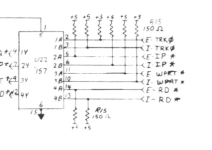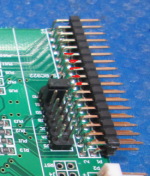behines
Member
I bought a TPI Drive
I bought a used/untested Texas Peripherals drive, to use as a second drive, with a Gotek being the first drive.
Thanks to some great help from some of the folks here, my Gotek is working now. The new physical drive is not yet working - the motor spins, but it does not otherwise respond (Error 02).
I have downloaded various Tandon disk service manuals and am prepared to work my way through them. The very first thing I did was some touch-up on the worn edge connectors - am currently waiting on my conductive ink pen ink to dry. (Procedure: Clean off the oxides with solder flux. Clean off the flux with isopropyl. Apply conductive ink.) If I'm extraordinarily lucky, it will just start working now.
I have no terminators, I think.
But meanwhile, I am wondering about terminators. I figure it would be good to get this right before going off on a deep dive of all the other potential things that could be wrong.
There are no terminators installed in the drive I bought, I *think*. (The Tandon TM100 manual shows a DIP resistor socket, which the TPI drive does not have. But it does have an unpopulated 6-pin SIP R51 right by the edge connector.)
It is my belief that the Gotek does not have terminators either. But it works fine. And the cable is pretty short, about a foot total.
Are terminators really needed?
I haven't seen a lot of discussion of them in the forum threads I've read. Maybe things just work fine most of the time without them?
If they are needed, one option would be to install them in the new TPI drive. Even though it's not right at the end of the cable, the reflections from the remaining stub should not be too severe.
If I do need to install them, what is called for? Looking at the schematic for the floppy controller in the tech ref, I see that there are a lot of lines with 150-ohm pull-ups on them. In some cases, the associated gates are open-collector types (7416). Others are just standard TTL (a 74157). But not all lines have these, so it's hard to tell from the schematic whether these are terminators or just strong pull-ups to improve rise times.


And there are a lot more 150-ohm resistors in the floppy controller than there are pins in the R51 socket. The original TM100 appears to have a 16-pin DIP terminator, so as many as 15 terminating resistors. So it doesn't seem like R51 is fulfilling the same function as the DIP terminator in the TM100.
And so
So my money is on, "They're not needed in the TRS-80, and in fact, the TPI drive doesn't even accommodate terminating resistors."
Do I have that right?
Thanks,
Brad
I bought a used/untested Texas Peripherals drive, to use as a second drive, with a Gotek being the first drive.
Thanks to some great help from some of the folks here, my Gotek is working now. The new physical drive is not yet working - the motor spins, but it does not otherwise respond (Error 02).
I have downloaded various Tandon disk service manuals and am prepared to work my way through them. The very first thing I did was some touch-up on the worn edge connectors - am currently waiting on my conductive ink pen ink to dry. (Procedure: Clean off the oxides with solder flux. Clean off the flux with isopropyl. Apply conductive ink.) If I'm extraordinarily lucky, it will just start working now.
I have no terminators, I think.
But meanwhile, I am wondering about terminators. I figure it would be good to get this right before going off on a deep dive of all the other potential things that could be wrong.
There are no terminators installed in the drive I bought, I *think*. (The Tandon TM100 manual shows a DIP resistor socket, which the TPI drive does not have. But it does have an unpopulated 6-pin SIP R51 right by the edge connector.)
It is my belief that the Gotek does not have terminators either. But it works fine. And the cable is pretty short, about a foot total.
Are terminators really needed?
I haven't seen a lot of discussion of them in the forum threads I've read. Maybe things just work fine most of the time without them?
If they are needed, one option would be to install them in the new TPI drive. Even though it's not right at the end of the cable, the reflections from the remaining stub should not be too severe.
If I do need to install them, what is called for? Looking at the schematic for the floppy controller in the tech ref, I see that there are a lot of lines with 150-ohm pull-ups on them. In some cases, the associated gates are open-collector types (7416). Others are just standard TTL (a 74157). But not all lines have these, so it's hard to tell from the schematic whether these are terminators or just strong pull-ups to improve rise times.


And there are a lot more 150-ohm resistors in the floppy controller than there are pins in the R51 socket. The original TM100 appears to have a 16-pin DIP terminator, so as many as 15 terminating resistors. So it doesn't seem like R51 is fulfilling the same function as the DIP terminator in the TM100.
And so
So my money is on, "They're not needed in the TRS-80, and in fact, the TPI drive doesn't even accommodate terminating resistors."
Do I have that right?
Thanks,
Brad


